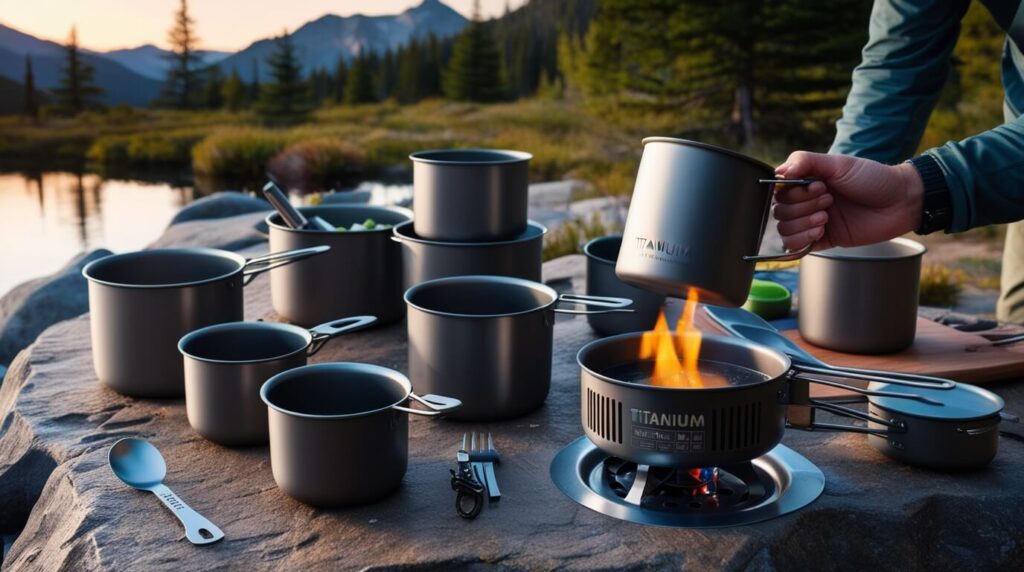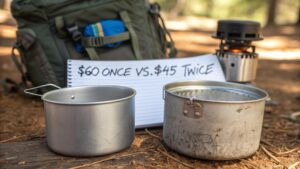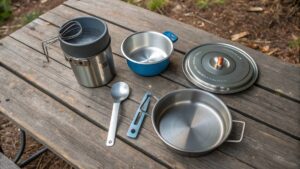Introduction:
Did you know that switching from traditional stainless steel to titanium cookware can reduce your pack weight by up to 60%? That’s right! For the average backpacker, this could mean carrying several pounds less weight on your next wilderness adventure. As outdoor enthusiasts continue to embrace the “ultralight” philosophy in 2025, titanium cookware has emerged as the gold standard for serious hikers, campers, and backpackers who refuse to compromise on performance.
I’ve spent countless hours testing different camping cookware materials, and let me tell you – titanium is absolutely revolutionary for those looking to lighten their load without sacrificing durability. This remarkable metal offers an unbeatable combination of strength, lightweight construction, and longevity that aluminum and stainless steel simply can’t match.
Whether you’re a weekend warrior or a thru-hiker tackling the Pacific Crest Trail, titanium camping cookware presents compelling advantages that might just transform your outdoor cooking experience. From its incredible resistance to corrosion to its non-reactive cooking surface, titanium brings a host of benefits that extend well beyond just weight savings.
In this comprehensive guide, we’ll explore why titanium has become the material of choice for discerning outdoor enthusiasts, examine its strengths and limitations, and help you determine if investing in titanium cookware is the right move for your specific camping style and needs. By the end, you’ll have all the information you need to make an informed decision about upgrading your camp kitchen with this premium material.
What Makes Titanium Special in the Backcountry?
Titanium has become something of a holy grail material in the outdoor gear world, and for good reason. Despite its incredible strength (comparable to steel), titanium is nearly 45% lighter than steel and significantly stronger than aluminum alternatives. But what really makes it stand out on the trail?
The Science Behind the Metal
Titanium’s unique properties come from its molecular structure. It’s classified as a transition metal on the periodic table (atomic number 22), and its strength-to-weight ratio is truly remarkable in the materials world. What this means for campers like me is simple: exceptional durability without the weight penalty.
The corrosion resistance of titanium is another factor that’s easy to overlook until you’ve experienced it firsthand. I’ve accidentally left my titanium pot damp in my pack for days (I know, I know—bad practice), yet it emerged without a hint of rust or corrosion. Try that with steel or iron cookware and you’ll quickly understand the difference.
My First Titanium Experience
I still remember cooking my first meal on titanium. After years of waiting for water to boil in heavy pots, the speed at which my new ultralight kettle heated water was nothing short of magical. That’s because titanium has excellent thermal conductivity—it heats up incredibly fast compared to stainless steel.
However, this superpower comes with a significant drawback that I learned the hard way: titanium doesn’t distribute heat evenly. My first attempt at cooking scrambled eggs resulted in a partially burned, partially raw concoction that even my trail-hungry stomach couldn’t justify eating. It was an important lesson in the limitations of this wonder metal.
The Real-World Benefits I’ve Experienced
After five years and countless wilderness meals prepared with titanium cookware, I’ve developed a profound appreciation for what it brings to my outdoor adventures.
The Ultralight Advantage
The most immediate benefit is obvious: weight savings. My complete titanium cook system—including pot, lid, mug, and spork—weighs a mere 10 ounces. Compare that to my old stainless steel setup that tipped the scales at over 2 pounds, and you can understand why ultralight hikers are willing to invest in titanium.
This weight reduction might seem insignificant in isolation, but when combined with other ultralight gear choices, it transforms the hiking experience. On longer treks, every ounce matters. I’ve found that shaving weight from my cookware allows me to either:
- Carry more food for longer expeditions
- Add luxury items that enhance camp comfort
- Simply enjoy the physical benefits of carrying less weight
Durability That Pays for Itself
The initial sticker shock of titanium cookware (often 2-3 times the cost of aluminum alternatives) can be hard to swallow. However, after years of use, my titanium pieces show virtually no wear. No dents, no scratches that compromise function, and certainly no rust.
In contrast, I’ve replaced aluminum pots multiple times due to warping and damage. When I calculate the long-term cost, my titanium investment has actually saved me money while providing peace of mind. I never worry about damaging my cookware when packing hastily or dropping it on rocky ground.
Comparing Titanium to Other Cookware Materials
Before committing to titanium, I experimented with nearly every material available for backcountry cooking. Here’s how they stack up based on my personal experience:
| Material | Weight | Durability | Heat Efficiency | Heat Distribution | Maintenance | Typical Cost | Best For |
|---|---|---|---|---|---|---|---|
| Titanium | ★★★★★ (Lightest) | ★★★★★ (Extremely durable) | ★★★★☆ (Heats quickly) | ★★☆☆☆ (Poor distribution) | ★★★★★ (Minimal) | $$$$ (Highest) | Ultralight backpacking, boiling water |
| Aluminum | ★★★★☆ (Very light) | ★★☆☆☆ (Dents easily) | ★★★☆☆ (Decent) | ★★★☆☆ (Fair) | ★★★☆☆ (Some care needed) | $$ (Affordable) | Budget backpacking, general cooking |
| Stainless Steel | ★★☆☆☆ (Heavy) | ★★★★☆ (Very durable) | ★★☆☆☆ (Slow to heat) | ★★★★☆ (Good distribution) | ★★★★☆ (Easy) | $$$ (Moderate) | Car camping, gourmet camp cooking |
| Cast Iron | ☆☆☆☆☆ (Heaviest) | ★★★★★ (Nearly indestructible) | ★☆☆☆☆ (Very slow to heat) | ★★★★★ (Excellent) | ★☆☆☆☆ (High maintenance) | $$ (Affordable) | Car camping, basecamp cooking |
| Hard-Anodized Aluminum | ★★★★☆ (Light) | ★★★☆☆ (Better than regular aluminum) | ★★★☆☆ (Good) | ★★★★☆ (Very good) | ★★★☆☆ (Some care needed) | $$$ (Moderate) | General backpacking, versatile cooking |
This comparison highlights why titanium has become my material of choice for most wilderness adventures, despite its limitations. The weight advantage alone makes it worth considering, especially for longer trips where every ounce matters.
Common Misconceptions I’ve Encountered
Throughout my outdoor adventures, I’ve heard many myths about titanium cookware that simply don’t hold up to real-world experience.
“Titanium Makes Food Taste Metallic”
This was a concern I had initially, but I’ve found it to be largely unfounded. Unlike some aluminum cookware, properly manufactured titanium creates a stable oxide layer that prevents metal from leaching into food. In my experience, there’s no detectable taste difference when using high-quality titanium cookware.
The exception might be highly acidic foods like tomato-based sauces, which can sometimes pick up a slight metallic taste when cooked for extended periods. However, for typical trail cooking—boiling water for dehydrated meals, cooking simple pastas, or preparing morning oatmeal—I’ve never noticed any flavor alteration.
“Titanium Is Indestructible”
While titanium is remarkably durable, it’s not immune to damage. The metal can dent if subjected to significant impact, though less readily than aluminum. More importantly, the extreme thinness of most titanium cookware (a necessity for weight reduction) means it can potentially warp if exposed to very high heat with nothing in the pot.
I learned this lesson when I absentmindedly left my titanium pot empty on a high-powered backpacking stove. The concentrated heat caused a slight depression in the center of the pot. It still functions perfectly, but it’s a reminder that even titanium has its limits.
“Titanium Cookware Is Only for Boiling Water”
While titanium excels at boiling water due to its quick heat transfer, dismissing it as a one-trick pony doesn’t give it enough credit. I’ve successfully cooked everything from pancakes to stir-fries in my titanium cookware—it just requires technique adaptation.
The key is learning to work with titanium’s heat characteristics rather than against them. Using lower heat settings, constant stirring, and selecting the right pot shape for specific cooking tasks can expand titanium’s culinary range considerably.
My Titanium Cookware Collection Evolution
Over the years, my titanium collection has evolved based on my changing needs and experiences. Here’s the journey of discovery that might help you avoid some of my costly trial and error:
Starting Simple: The Mug-Pot Combo
My first titanium purchase was a Snow Peak Trek 700 mug-pot combo. This versatile 700ml pot doubles as a mug and can handle most solo cooking needs. At just 4.2 ounces, it was a revelation compared to my previous cookware.
For simple weekend trips where I’m primarily rehydrating freeze-dried meals, this remains my go-to solution. The wide mouth makes eating directly from the pot comfortable, and the foldable handles never get too hot to handle.
Expanding for Group Cooking
When I started taking wilderness trips with my partner, the limitations of my minimalist setup became apparent. We upgraded to a complete cooking system: the TOAKS Titanium 1100ml Pot with companion cups and a small frying pan.
The larger pot accommodates meals for two people comfortably, and the slight weight increase (still under 8 ounces for the pot alone) was negligible compared to the cooking flexibility gained. The frying pan, while not perfect for heat-sensitive cooking due to titanium’s heat distribution issues, works surprisingly well for simple morning pancakes or evening quesadillas.
Specialized Additions
As my backcountry cooking ambitions grew, so did my titanium collection. My most recent addition is a Vargo Titanium BOT (Bottle Pot)—an ingenious design that functions as both water bottle and cooking pot. This hybrid solution saves pack space and allows me to collect water on the go, then cook with the same container.
For winter camping, I’ve added a windscreen and heat reflector that perfectly fits my titanium pot, dramatically improving fuel efficiency in cold conditions.
The Learning Curve: Mastering Titanium Cookware Techniques
The transition to titanium cooking wasn’t without challenges. The material’s poor heat distribution means it develops hot spots easily—a recipe for burned food if you’re not careful. Here are some techniques I’ve developed to work around these limitations:
Lower Heat Is Your Friend
I’ve learned to use significantly lower heat settings than I would with other cookware. Titanium transfers heat so efficiently that medium-low often performs like high heat on traditional pots. This adjustment alone prevented many potential cooking disasters.
The Constant Stir Method
When cooking anything beyond simply boiling water, constant attention and stirring are essential. I’ve developed what I call the “titanium shuffle”—a continuous, gentle stirring motion that prevents food from settling in hot spots long enough to burn.
Strategic Pot Selection
For different cooking tasks, I’ve learned to select titanium cookware with appropriate characteristics:
- Wide, shallow pots work better for cooking foods that need stirring
- Tall, narrow pots are ideal for boiling water efficiently
- Thicker-bottomed titanium pieces (though slightly heavier) provide marginally better heat distribution for more delicate cooking
This strategic approach has expanded the range of meals I can successfully prepare in the backcountry without resorting to heavier cookware alternatives.
The Economics of Titanium: Justifying the Investment
Let’s address the elephant in the room: titanium cookware is expensive. A basic titanium pot can easily cost three times as much as its aluminum counterpart. Is it worth it? Here’s my cost-benefit analysis after years of use:
Initial Investment vs. Longevity
My first titanium pot cost $60—a sum that seemed outrageous at the time for what was essentially a glorified cup. Five years later, that same pot shows minimal wear and performs exactly as it did on day one. In contrast, I went through two aluminum pots in the two years before switching to titanium, spending roughly $45 total on replacements.
The durability factor alone begins to justify the price difference over time, especially for frequent backcountry travelers.
Weight Savings as Currency
For dedicated hikers, weight reduction has tangible value. Carrying less weight means:
- Reduced physical strain and injury risk
- Increased daily mileage potential
- Enhanced overall enjoyment
While difficult to quantify precisely, I consider the premium paid for titanium cookware as an investment in comfort and expanded capabilities. The ability to tackle longer routes or more challenging terrain because of a lighter pack is worth something substantial to passionate outdoors people.
Fuel Efficiency Considerations
Titanium’s rapid heat transfer properties have resulted in noticeably improved fuel efficiency in my experience. I typically use about 20% less fuel compared to my old stainless steel setup for the same cooking tasks. Over many trips, this represents both cost savings and environmental benefits, as well as the practical advantage of carrying less fuel weight.
My Ultimate Titanium Cookware Recommendations
After extensive personal testing and conversations with fellow outdoor enthusiasts, here are my top recommendations for different scenarios:
For the Solo Ultralight Minimalist
The TOAKS Titanium 550ml Pot hits the sweet spot for solo travelers focused on weight savings. At just 2.6 ounces with lid, it’s large enough for one-person meals yet incredibly light. Paired with a titanium spork, this setup handles most backcountry cooking needs for minimal weight penalty.
For Couples or Small Groups
The Snow Peak Multi Compact Cookset offers remarkable versatility for two people. The nesting design includes two pots, a pan, and two cups in an integrated package weighing just 11.6 ounces. The slight weight increase compared to ultraminimalist options is justified by the cooking flexibility gained.
For Winter Camping Specialists
The MSR Titan Kettle has proven itself exceptional for snow-melting duties. Its wide bottom maximizes contact with heat sources, and the 0.85-liter capacity offers enough volume for melting snow efficiently without excessive fuel consumption.
For Backcountry Gourmets
Despite titanium’s cooking limitations, the Evernew Titanium Pasta Pot has become my favorite for more ambitious backcountry culinary adventures. The oval shape and slightly thicker bottom provide marginally better heat distribution, making it possible to cook more complex meals with careful technique.
Beyond the Basics: Titanium Accessories That Enhance the Experience
My titanium journey didn’t stop with pots and pans. I’ve discovered several complementary items that enhance the overall cooking system:
Titanium Utensils Worth Considering
The Snow Peak Titanium Spork has traveled with me for thousands of miles. At just 0.6 ounces, it’s the perfect balance of weight, durability, and functionality. The slightly longer handle compared to some competitors prevents knuckle-burning when reaching into deep pots.
For more sophisticated cooking, I occasionally pack a TOAKS Titanium Long Handle Spoon, which weighs just 0.7 ounces but provides excellent reach for stirring and serving from deeper pots.
Integrated Cooking Systems
While not pure titanium solutions, hybridized cooking systems like the Jetboil Titanium Companion Cup combine titanium’s weight benefits with aluminum’s heat distribution properties. These systems represent an excellent compromise for those who want titanium’s durability without sacrificing cooking performance.
DIY Modifications That Improved My Experience
I’ve made several customizations to my titanium cookware that significantly enhanced functionality:
- Added silicone grip covers to pot handles for improved heat protection
- Created a DIY reflective cozy from emergency blanket material to improve heat retention while eating
- Fashioned pot lid lifters from twisted wire to avoid burned fingers
These simple modifications cost almost nothing but dramatically improved the practical usability of my titanium cookware system.
The Environmental Perspective on Titanium
As someone who values environmental responsibility, I’ve considered the sustainability aspects of titanium cookware compared to alternatives.
Production Impacts
Titanium extraction and processing require significant energy input, potentially giving the material a larger initial carbon footprint than some alternatives. However, this impact should be considered alongside the product’s exceptional lifespan.
My titanium cookware has outlasted multiple aluminum counterparts that would have eventually ended up in landfills. This longevity factor substantially reduces the lifetime environmental impact per use.
Recyclability Considerations
While titanium is theoretically 100% recyclable, the practical reality is that specialized titanium recycling facilities aren’t widely accessible to most consumers. This is an area where the industry has room for improvement, though the exceptional durability of titanium products somewhat mitigates this concern.
Wilderness Conservation Impact
An often-overlooked environmental benefit of ultralight gear like titanium cookware is its contribution to Leave No Trace principles. Lighter packs mean:
- Less strain on trail infrastructure
- Reduced temptation to shortcut switchbacks or damage vegetation when tired
- Less physical impact on sensitive backcountry surfaces
These subtle benefits align perfectly with responsible wilderness use.
Caring for Titanium: Lessons Learned
One of titanium’s greatest advantages is its minimal maintenance requirements. However, I’ve developed some care practices that help maintain optimal performance:
Cleaning in the Field
On the trail, I clean my titanium cookware using the “leave no trace” method:
- Scrape out any food residue (pack it out)
- Rinse with a small amount of water
- Use sand or snow as a gentle abrasive if necessary
- Dry thoroughly before packing
This simple process keeps my cookware clean without chemical cleaners or excessive water use.
Long-Term Maintenance
At home between trips, I occasionally perform a more thorough cleaning:
- Soaking in warm, soapy water to remove any stubborn residue
- Using a soft brush rather than abrasive scrubbers
- Ensuring complete drying before storage
Despite titanium’s natural corrosion resistance, I still store cookware with lids off or loosely fitted to prevent any possibility of moisture accumulation.
Addressing Common Issues
The bluish-purple discoloration that sometimes appears on titanium cookware after heating is completely harmless. It’s simply an oxide layer forming on the metal surface and doesn’t affect performance or food safety. I actually find this patina quite beautiful—a visual record of adventures past.
Where Titanium Falls Short: Being Honest About Limitations
My enthusiasm for titanium cookware is obvious, but intellectual honesty requires acknowledging its shortcomings:
The Heat Distribution Problem
As mentioned earlier, titanium’s poor heat distribution remains its primary functional drawback. For recipes requiring precise temperature control or even cooking across the entire pot surface, titanium simply cannot compete with materials like cast iron or aluminum.
I’ve learned to work around this limitation, but it’s something every potential titanium cook should understand before investing.
The Challenge of Simmering
Achieving a true simmer in titanium cookware requires vigilance and technique. The metal transfers heat so efficiently that maintaining the delicate balance needed for simmering can be frustrating, especially with powerful backpacking stoves.
I’ve found that using a heat diffuser can help mitigate this issue somewhat, though at the cost of added pack weight.
Limited Pot Size Options
The market for titanium cookware caters primarily to backpackers seeking weight savings. Consequently, truly large titanium pots suitable for group cooking are relatively rare and extraordinarily expensive when available.
For trips with more than 2-3 people, I often resort to alternative materials despite my preference for titanium’s performance characteristics.
Conclusion:
Titanium camping cookware represents a significant advancement in outdoor culinary equipment, combining remarkable durability with incredible weight savings that can transform your wilderness experience. Throughout this guide, we’ve explored the numerous advantages that make titanium a premier choice for outdoor enthusiasts, from its exceptional strength-to-weight ratio to its impressive corrosion resistance.
As we’ve discussed, titanium isn’t without its challenges – the higher price point and unique heat distribution properties require some adjustment. However, for serious backpackers, hikers, and campers who value weight reduction and long-term durability, these minor drawbacks are easily outweighed by the benefits. The initial investment in quality titanium cookware typically pays dividends over years of reliable use in the harshest conditions.
Your specific camping style and cooking preferences should ultimately guide your titanium cookware selection. Ultralight backpackers might prioritize the absolute lightest options despite some functional trade-offs, while those who enjoy more elaborate camp cooking might benefit from slightly heavier titanium sets with additional features or hybrid designs that improve heat distribution.
Whether you’re replacing your first worn-out aluminum pot or finally deciding to shed those extra ounces from your pack weight, titanium cookware offers a premium solution that will likely outlast much of your other gear. Take the leap to titanium – your back will thank you on those long uphill stretches, and your taste buds will appreciate the reliable, safe cooking surface for countless outdoor meals to come. The wilderness is calling – pack light, pack right, and make titanium part of your outdoor cooking arsenal in 2025.
Additional Resources
- Minimalist Camp Kitchen Setup: This will help you create a more efficient outdoor cooking system.
- How to Make Dehydrated Camping Meals: Learn how to pack food that is lightweight, doesn’t spoil and tastes good.
- The Ultimate Guide to Long-Term Camping Food Storage: Learn proven methods, essential gear, and expert strategies to keep your food fresh, safe, and accessible.
- The Ultimate Guide to Dutch Oven Cooking While Camping: Learn about off-grid camp cooking and recipes.
- Easy One-Pot Off-Grid Camping Meals for Outdoor Adventures: Learn my absolute favorite one-pot wonders that will fuel your wilderness adventures.
- Fireless Cooking Methods: Learn essential fireless cooking methods for remote camping
- Wilderness Cooking Techniques: Learn the best cooking techniques in the wilderness that will give you the best outdoor meal experience.
- 10 Campfire Recipes That Won’t Bomb: Check out this curated list of campfire recipes that keep you going off-grid during camping
- Ultimate Guide to Wilderness Survival Skills: Talks comprehensively about survival skills in the wild or off-grid.
- How to Stay Safe While Camping Off-Grid: Offers safety and survival tips in the wilderness






